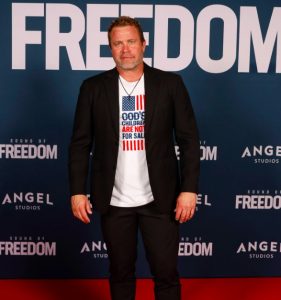But according to Erin Albright, an attorney and longtime adviser to anti-trafficking task forces, Ballard and OUR aren’t actually central to the international fight against human trafficking. “The majority of the [anti-trafficking] field views them as fringe,” she tells me. “They peddle sensationalism…and they fundraise off it.”
In 2018, when Monteverde was making his movie, these critiques weren’t part of the conversation. “I never in a million years imagined that this would be political,” he said of the film, which would become a Ballard biopic—albeit one that takes great liberties with the facts. After all, he says, “I saw the piece [on child trafficking] on the mainstream media … I always thought that this was going to be a film that we would all come together over.”
If this movie had been released shortly after it was made, that might have happened. Sound of Freedom was independently produced for a reported $14.5 million and financed mainly by a group of Mexican backers, according to the filmmakers. But like many other projects, the film lost its distributor when Disney acquired 21st Century Fox in 2019. Sound of Freedom remained on the shelf until it was picked up by Provo, Utah–based Angel Studios in 2023, with a plan to release the film in theaters around the country.
Several critical things happened in the years between the film’s wrap and its arrival in theaters. In a series that kicked off in 2020, Vice journalists Anna Merlan and Tim Marchman began a probe of Ballard and OUR, discovering “a pattern of image-burnishing and mythology-building, a series of exaggerations that are, in the aggregate, quite misleading.” In a subsequent report, they alleged Ballard and his organization had engaged in “blundering missions—carried out in part by real estate agents and high-level donors—that seemed aimed mainly at generating exciting video footage.” (Ballard has not yet responded to Vanity Fair’s requests for comment. Though a representative from Angel Studios initially proposed an interview with Ballard, they later said they were unable to reach him to arrange a meeting.)
These reports were widely read and shared but were reviled as often as they were praised. That’s because of a second development: the QAnon set of conspiracy theories, which originated in 2017 and gradually gained notice by the mainstream in the ensuing years. The movement’s “core falsehood,” as The New York Times put it, asserts that “a group of Satan-worshiping elites who run a child sex ring are trying to control our politics and media.”
Around late 2020, QAnon started to use claims about child trafficking as an outreach strategy. As The New York Times reported at the time, adherents began “flooding social media with posts about human trafficking, joining parenting Facebook groups and glomming on to hashtag campaigns like #SaveTheChildren,” then moving “the conversation to baseless theories about who they believe is doing the trafficking: a cabal of nefarious elites that includes Tom Hanks, Oprah Winfrey and Pope Francis.”

